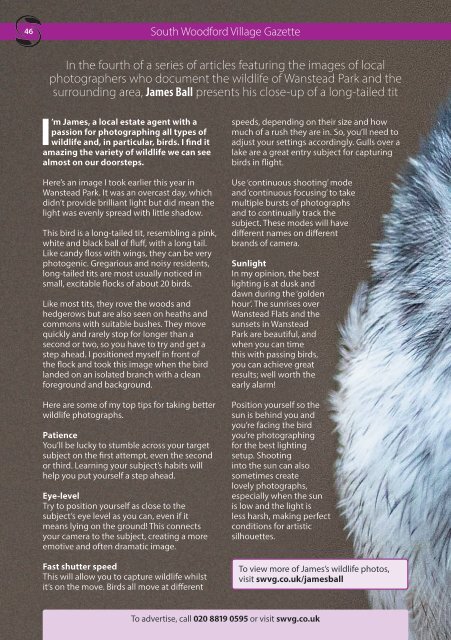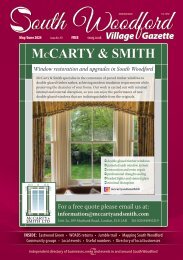Sep/Oct 2023
You also want an ePaper? Increase the reach of your titles
YUMPU automatically turns print PDFs into web optimized ePapers that Google loves.
46<br />
South Woodford Village Gazette<br />
In the fourth of a series of articles featuring the images of local<br />
photographers who document the wildlife of Wanstead Park and the<br />
surrounding area, James Ball presents his close-up of a long-tailed tit<br />
I’m James, a local estate agent with a<br />
passion for photographing all types of<br />
wildlife and, in particular, birds. I find it<br />
amazing the variety of wildlife we can see<br />
almost on our doorsteps.<br />
Here’s an image I took earlier this year in<br />
Wanstead Park. It was an overcast day, which<br />
didn’t provide brilliant light but did mean the<br />
light was evenly spread with little shadow.<br />
This bird is a long-tailed tit, resembling a pink,<br />
white and black ball of fluff, with a long tail.<br />
Like candy floss with wings, they can be very<br />
photogenic. Gregarious and noisy residents,<br />
long-tailed tits are most usually noticed in<br />
small, excitable flocks of about 20 birds.<br />
Like most tits, they rove the woods and<br />
hedgerows but are also seen on heaths and<br />
commons with suitable bushes. They move<br />
quickly and rarely stop for longer than a<br />
second or two, so you have to try and get a<br />
step ahead. I positioned myself in front of<br />
the flock and took this image when the bird<br />
landed on an isolated branch with a clean<br />
foreground and background.<br />
Here are some of my top tips for taking better<br />
wildlife photographs.<br />
Patience<br />
You’ll be lucky to stumble across your target<br />
subject on the first attempt, even the second<br />
or third. Learning your subject’s habits will<br />
help you put yourself a step ahead.<br />
Eye-level<br />
Try to position yourself as close to the<br />
subject’s eye level as you can, even if it<br />
means lying on the ground! This connects<br />
your camera to the subject, creating a more<br />
emotive and often dramatic image.<br />
Fast shutter speed<br />
This will allow you to capture wildlife whilst<br />
it’s on the move. Birds all move at different<br />
speeds, depending on their size and how<br />
much of a rush they are in. So, you’ll need to<br />
adjust your settings accordingly. Gulls over a<br />
lake are a great entry subject for capturing<br />
birds in flight.<br />
Use ‘continuous shooting’ mode<br />
and ‘continuous focusing’ to take<br />
multiple bursts of photographs<br />
and to continually track the<br />
subject. These modes will have<br />
different names on different<br />
brands of camera.<br />
Sunlight<br />
In my opinion, the best<br />
lighting is at dusk and<br />
dawn during the ‘golden<br />
hour’. The sunrises over<br />
Wanstead Flats and the<br />
sunsets in Wanstead<br />
Park are beautiful, and<br />
when you can time<br />
this with passing birds,<br />
you can achieve great<br />
results; well worth the<br />
early alarm!<br />
Position yourself so the<br />
sun is behind you and<br />
you’re facing the bird<br />
you’re photographing<br />
for the best lighting<br />
setup. Shooting<br />
into the sun can also<br />
sometimes create<br />
lovely photographs,<br />
especially when the sun<br />
is low and the light is<br />
less harsh, making perfect<br />
conditions for artistic<br />
silhouettes.<br />
To view more of James’s wildlife photos,<br />
visit swvg.co.uk/jamesball<br />
To advertise, call 020 8819 0595 or visit swvg.co.uk
















